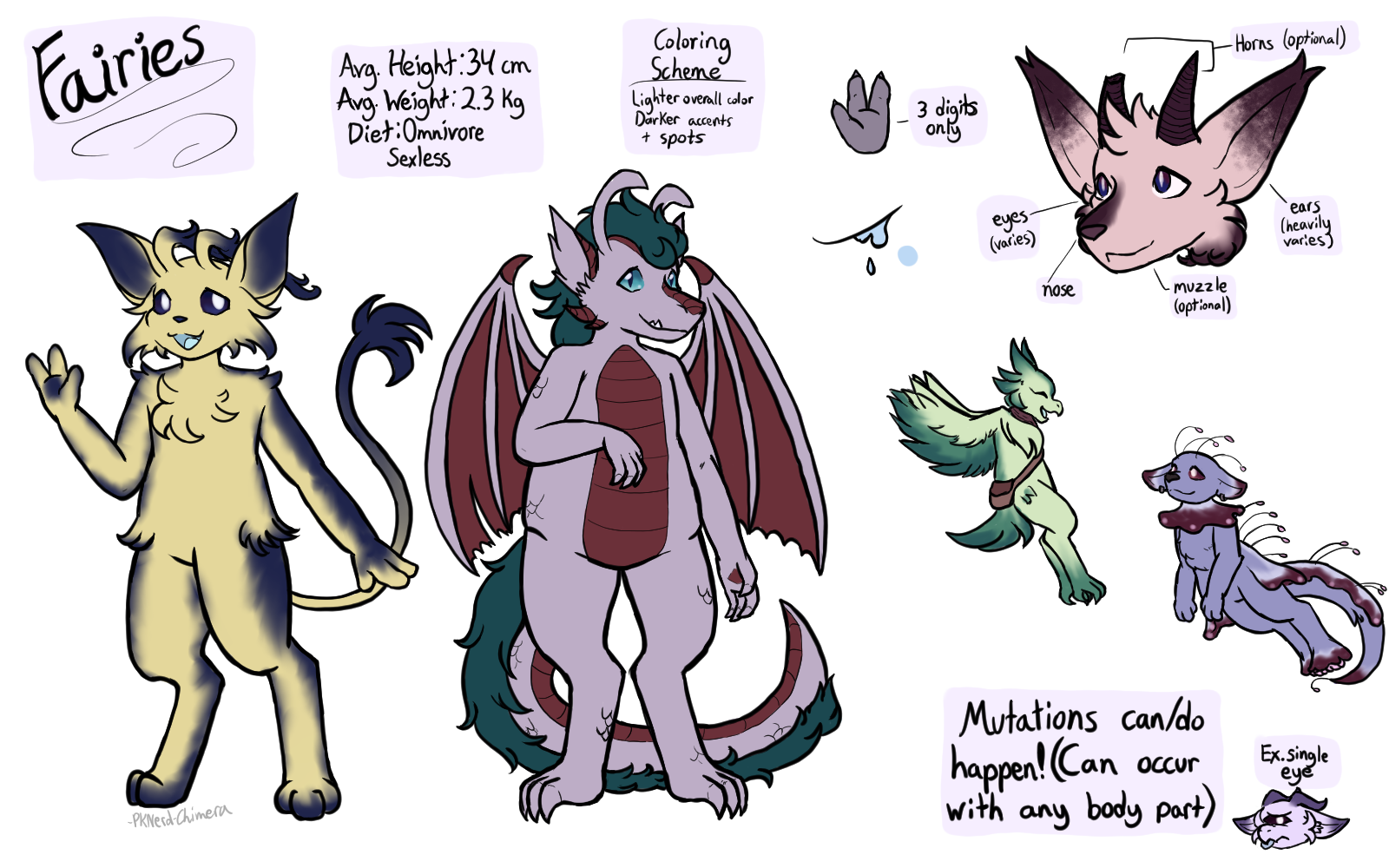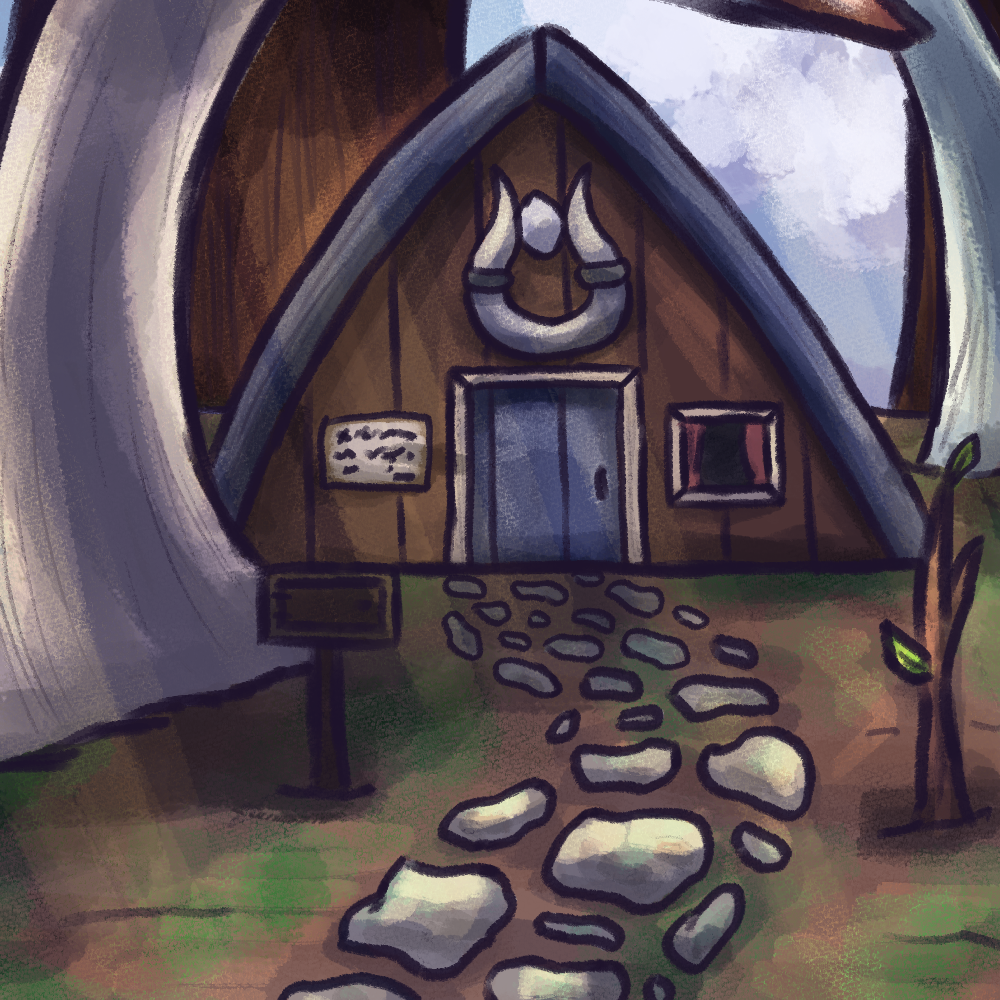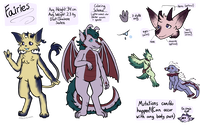Faekin
PKNerdChimera
- Created
- 14 days, 10 hours ago
- Creator
- PKNerdChimera
- Favorites
- 1
Profile
Faekin
Contents [hide]
Faekin are a sentient species native to the world of Luxsolis. They live in all areas on the habitable zones of the planet, with population density varying heavily depending on location. They are naturally attuned to magic, which heavily influences all parts of themselves, save for, typically, personalities. They are a social species, rarely living fully alone, whether in their own villages or in rural townships.

It's commonly believed that, compared to mortals, fairies feel a closer connection to the gods due to their connection to magic. While this has previously caused problems with their public reception in the Age of Seperation, this has been more easily reconciled in recent years, often to where now faekin libraries/repositories are critical to reviving much older traditions that would've been lost to time.
| Faekin | |
 |
|
| Scientific Classification | |
| Alternate Names | Fairies/fairy, fae |
| Life Span | 115-150 yrs. |
| Average Height | 34 cm/1.3 ft |
| Average Weight | 2.3 kg/6.18 lbs |
| Diet Type | Omnivore (Plant preference observed) |
Biology

A baby fairy. Their markings/patterns on their bodies may have yet to form, and they have a bigger limbs until they grow older.
Characteristics
Faekin are a small species that, unlike most mortals, are beings that embody and are most influenced my magic. Each fairy can carry a number of characteristics that exist in all other non-humanish species on Luxsolis. Commonly, each individual has a strong association to one element of magic, where it can influence their appearance and abilities (though not always). This element can change over the course of one's life, but this is a very gradual process and needs to be initiated by the individual themselves.
All fairies require oxygen to breathe, as do the rest of mortals. However, they are uniquely resistant to most normal diseases, and are immune to transformative diseases (like vampirism or beasthropy). However, they are also extremely weak in any environment with little/no magic, and can quickly die if deprived of magic within the natural world.
Their internal organs consist of what is to be expected of mammalians, with light-blue blood. Since fairies do not reproduce with each other, they have no reproductive organs. Additionally, while fairies may enter romantic relationships with each other, they are completely asexual.
Life Cycle
Each fairy is born from a fae tree, either as an an individual or with siblings. After they form, they take about 20 years to be considered a young adult.
Typical Life Periods
- Baby (0-5 yrs)
- Young Child (6-15 yrs)
- Teen (16-29 yrs)
- Young Adult (30-55-ish yrs)
- Median Adult (55-75 years)
- Wisen Adult (75-100 years)
- Elder (100 yrs-Death)
Children in a village are raised by the adults in the village collectively, usually given their own dedicated homing while growing up (typically living with multiple other kids). How this is handled is usually governed by a leader of a village, with changes happening as-needed. Additionally, if desired, elders often choose to live together to support one another in ways that wouldn't be challenging as younger fae.
While
Reproduction
Unlike most other species on Luxsolis, fairies do not reproduce in the traditional sense of all other mortals. Instead, reproduction begins at the death of a fairy, where their form becomes a small seed. From there, whether because the seed eventually sinks into the environment, or is deliberately planted, the seed eventually grows into a fae tree.
Once the tree matures, not only does it become a source of healing/magic for the environment, it also can spawn a new fairy(or multiple fairies) during its lifetime. The newborn fairy can inherit traits of the 'parent' fairy, but this is not always the case. Fae trees stay alive for up to millennium, maturing around 20-35 years of age (depending on environment).
Fairies that are born of the same tree are considered siblings, and can sometimes share characterstics/abilities. While this does not always occur, twins/triplets can also occur. Additionally, fairies can be spawned at multiple times during a fae tree's life.
Distribution/Environment

Some fairies live a nomadic life, though typically this is done for a love of travel.
While fairies live everywhere on the planet's 'main' surface, most fairies are congregated in the wilderness, outside of mortal dwellings/towns/cities. What they can look like/their magical abilities also heavily influenced by their surroundings, and can sometimes influence their personality, as well.
If they are able to, some fairies are well-adapted enough to travel around the world, whether by themselves or in very small groups. These nomads are more likely than other fairies to reside in mortal cities/towns for a while. Additionally, they also can be an important source of trading between villages.
Adaptations
With the environment, a fairy's body often adapts to it in a variety of ways. As an example, areas near the ocean or other large bodies of water will have an influx of fae that are able to dive deep and/or hold their breath for much longer periods than typical. These adaptations are usually grown into during childhood, up until adulthood. Even with this, sometimes how their body grows can not always fit with the environment, depending on circumstances.
Sociality

One example of what a fairy's house can look like. Houses are usually made with materials within the environment.
Villages
Typically, fairies within an area will form a village, usually as long as one doesn't already exist (though villages may also form due to pre-existing issues with an established village.
Villages can range anywhere from 5 to a few thousand members at any given time, depending on the village's age, inhabitants, location, and multiple other factors. These villages are usually governed by either 1 or multiple fairies, with their own political structures changing over time. Multiple roles/jobs are delegated to different groups of fairies, depending on the needs of the village (though some needs, like food, are a constant).
Some roles can carry more prestiage and a higher respect for the fae within the role (for example, leaders and historians). Despite this, it's heavily discouraged to disrespect a role, especially ones that can seem more 'trivial' at first.
Villages almost always reside outside of mortal cities/towns, due to previous tensions from the previous era. While extremely rare, some villages host mortal inhabitants, should there be interest. These members are also mormally given the same expectations as the rest of the villagers. Often due to village structure, not more than several mortals at a time can usually live in a village.
Interactions with Mortals
Fairies are far from a secret for almost-all mortals, with some seeing a fairy a least a few times within their lifetime. In the first era, it was extremely common for mortals and fairies to be in much closer communication between towns and villages.
During the second era, after gods were largely abandoned by mortals, most fae villages fundamentally disagreed with the decision, which lead to both groups growing much father apart, making it significantly more rare for interactions/communcation to occur. As the third era continues on, fairies and mortals are working out how to stay in communication, like how the latter is re-adapting to speaking to the gods again.




Comments